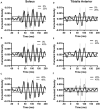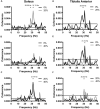Subthreshold Electrical Noise Applied to the Plantar Foot Enhances Lower-Limb Cutaneous Reflex Generation
- PMID: 33005140
- PMCID: PMC7479210
- DOI: 10.3389/fnhum.2020.00351
Subthreshold Electrical Noise Applied to the Plantar Foot Enhances Lower-Limb Cutaneous Reflex Generation
Abstract
Reflex responses generated by cutaneous mechanoreceptors of the plantar foot are important for the maintenance of balance during postural tasks and gait. With aging, reflex generation, particularly from fast adapting type I receptors, is reduced, which likely contributes to impaired postural stability in this population. Therefore, improving reflex generation from these receptors may serve as a tool to improve balance performance. A mechanism to enhance reflexes may lie in the phenomenon of stochastic resonance, whereby the addition of certain intensities and frequencies of noise stimuli improves the performance of a system. This study was conducted to determine whether tactile noise stimuli could improve cutaneous reflex generation. In 12 healthy young adults, we evoked cutaneous reflex responses using a 0-50 Hz Gaussian noise vibration applied to the plantar heel. Concurrently, we applied one of six subthreshold intensities of electrical tactile noise to the plantar heel [0%, 20%, 40%, 60%, 80% or 100% (threshold)] and were able to analyze data from 0%, 20% and 40% trials. Across participants, it was found that the addition of a 20% perceptual threshold (PT) noise resulted in enhanced reflex responses when analyzed in both the time and frequency domains. These data provide evidence that cutaneous reflex generation can be enhanced via a stochastic resonance effect and that 20% PT is the optimal intensity of noise to do so. Therefore, the addition of noise stimuli may be a valuable clinical intervention to improve reflex responses associated with postural balance in populations with impairments.
Keywords: cutaneous reflex; foot sole; lower limb; stochastic resonance; subthreshold noise.
Copyright © 2020 Sharma, Peters and Bent.
Figures




Similar articles
-
Calf cutaneous stimulation generates reflexes in the thigh that can be modified by subthreshold noisy vibration.J Neurophysiol. 2023 Jul 1;130(1):199-211. doi: 10.1152/jn.00497.2022. Epub 2023 Jun 28. J Neurophysiol. 2023. PMID: 37377219
-
Losing touch: age-related changes in plantar skin sensitivity, lower limb cutaneous reflex strength, and postural stability in older adults.J Neurophysiol. 2016 Oct 1;116(4):1848-1858. doi: 10.1152/jn.00339.2016. Epub 2016 Aug 3. J Neurophysiol. 2016. PMID: 27489366 Free PMC article.
-
Heating the skin on the foot sole enhances cutaneous reflexes in the lower limb.J Appl Physiol (1985). 2023 Nov 1;135(5):985-994. doi: 10.1152/japplphysiol.00533.2023. Epub 2023 Sep 7. J Appl Physiol (1985). 2023. PMID: 37675471
-
How can the stimulation of plantar cutaneous receptors improve postural control? Review and clinical commentary.Neurophysiol Clin. 2019 Jun;49(3):263-268. doi: 10.1016/j.neucli.2018.12.006. Epub 2019 Jan 11. Neurophysiol Clin. 2019. PMID: 30639034 Review.
-
Contributions to the understanding of gait control.Dan Med J. 2014 Apr;61(4):B4823. Dan Med J. 2014. PMID: 24814597 Review.
Cited by
-
Reducing the foot trajectory variabilities during walking through vibratory stimulation of the plantar surface of the foot.Sci Rep. 2021 Mar 29;11(1):7125. doi: 10.1038/s41598-021-86583-7. Sci Rep. 2021. PMID: 33782523 Free PMC article.
-
Mechanics and energetics of human feet: a contemporary perspective for understanding mobility impairments in older adults.Biomechanics (Basel). 2022 Dec;2(4):494-499. doi: 10.3390/biomechanics2040038. Epub 2022 Sep 23. Biomechanics (Basel). 2022. PMID: 38249991 Free PMC article.
-
Effectiveness and safety of subthreshold vibration over suprathreshold vibration in treatment of muscle fatigue in elderly people.World J Clin Cases. 2023 May 26;11(15):3434-3443. doi: 10.12998/wjcc.v11.i15.3434. World J Clin Cases. 2023. PMID: 37383890 Free PMC article. Review.
References
-
- Amjad A. M., Halliday D. M., Rosenberg J. R., Conway B. A. (1997). An extended difference of coherence test for comparing and combining several independent coherence estimates: theory and application to the study of motor units and physiological tremor. J. Neurosci. Methods 73, 69–79. 10.1016/s0165-0270(96)02214-5 - DOI - PubMed
LinkOut - more resources
Full Text Sources

